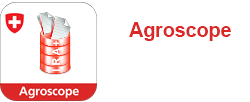Increasing the soil carbon stock by optimizing the grassland management is seen as a potential cost-effective mitigation strategy to counteract greenhouse gas (GHG) emissions from pasture fields associated with the application of fertilizer or cattle excreta. This study presents results of GHG flux measurements in a paired field experiment of two neighboring grazing systems over a full year. Each pasture was grazed by 12 dairy cows in a rotational grazing management. Different feeding strategies (system G: grazing only; system M: grazing with supplement of maize silage) resulted in different nitrogen excretion rates. The field scale emissions of CO2, methane (CH4) and nitrous oxide (N2O) were quantified using the eddy covariance (EC) technique on both parallel pasture fields excluding the direct emissions by the animals. Small-scale CH4 emissions from excreta patches and background areas were also measured using the ‘fast-box’ chamber technique. The fast-box measurements dominated by dung patch emissions were up-scaled to the field and compared to the EC measurements revealing some discrepancies between the two measurement approaches. N2O emissions resulted mainly from slurry and mineral fertilization (44 ± 17%) while both animal excreta and background emissions contributed each about 28% to the annual emissions. Total N2O emissions amounted to 3.8 ± 1.1 kg N2O-N ha−1 yr−1 and 3.7 ± 1.4 kg N2O-N ha−1 yr−1 for the pasture fields M and G, respectively. In order to determine the net ecosystem carbon budget (NECB) of the pasture fields, additional non-gaseous carbon fluxes were either measured (harvest, slurry application) or estimated based on an animal feeding model (grazing intake, excreta). For the investigated year, the NECB (negative sign indicating sequestration) resulted in –103 ± 74 g C m−2 yr−1 and –63 ± 67 g C m−2 yr−1 for pastures M and G, respectively, indicating the tendency of carbon storage especially in the pasture M soil. However, the emissions of CH4 and N2O almost balanced the NECB resulting in non-significant (near-neutral) net GHG budgets for the pasture soils (field M:–144 ± 277 g CO2-eq. m−2 yr−1, field G:–9 ± 256 g CO2-eq. m−2 yr−1). Due to the paired plot design of the experiment, the difference between the two pasture fields was significant with pasture M showing a reduction in net GHG emissions by 135 ± 89 g CO2-eq. m−2 yr−1 compared to pasture G.
Voglmeier K., Six J., Jocher M., Ammann C.
Soil greenhouse gas budget of two intensively managed grazing systems.
Agricultural and Forest Meteorology, 287, 2020, 1-12.
Download inglese (606 kB)
ISSN Print: 0168-1923
ISSN Online: 1873-2240
Digital Object Identifier (DOI): https://doi.org/10.1016/j.agrformet.2020.107960
ID pubblicazione (Codice web): 43968 Inviare via e-mail










